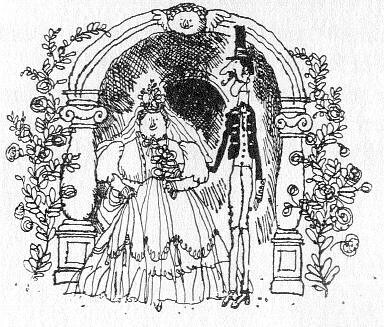The first whiff was sent floating under my nose by Daniel Hahn (editor of the Oxford Companion to Children's Literature) - whose recent top 10 of forgotten children's classics included the delightful Fattypuffs and Thinnifers by Andre Maurois with charming Fritz Wenger illustrations. This was a top favourite of mine as a child - I think I liked the pictures and the entirely logical but surreal scenario.
 |
| Fattypuffs and Thinifers marry (Fritz Wenger) |
Then last weekend, the Guardian invited a selection of contemporary authors to list the children's books which made them, and I was nearly overcome by the rosy fumes (not in an unpleasurable way). It's always interesting to read these, because as we know, the books we read as children exercise some of the most formative influences on our imagination - if by no means conclusive ones. Golden classics from the canon dominated, from Andrew Laing's Fairy Tales (the late Ruth Rendell) to Arthur Ransom's Peter Duck (Tom Stoppard.) Of course, that almost renders the exercise irrelevant. If you're trying to divine the secret reading which has created a fine modern literary mind and only discover that they liked Alice in Wonderland, it's hardly a startling, distinctive or unique piece of bibliography.
| The edition of Peter Duck I read |
This is my problem with nostalgia. Often we rewrite things to suit modern tastes or what we think other readers will want to read, or identify with. I'm just as bad. In schools, when children ask, "What was your favourite book as a child?", I too often give them the answers they have probably heard before, were maybe even hoping for. The Narnia books, Stig of the Dump, The Hobbit, The Silver Sword - all great books, but chances are they are all titles so well known that they are bound to have crossed the paths of most keen young readers in the last fifty years.
 |
| Stig of the Dump (illustrated Edward Ardizzone) |
I'm delighted to keep on reinforcing their appeal, they're great books.
But of course, there were so many other influences on my imagination. Namely, some books which all too rarely get chosen as favourites by Serious Living Writers, and that's picture books. Yes, I loved the characters and adventures and drama and humour of those more canonical titles, but the books that blew my child mind and implanted haunting images there forever? The books that gave me a sense of the limitless, dream manufacturing capability of the subconscious?
Books like the German Ra Ta Ta Tam - The strange story of a little engine, by Peter Nickl, illustrated by Binette Schroder, the tale of a lonely train traversing Dali-esque landscapes filled with obscure symbolism and mystery.
| Ra Ta Ta Tam |
Or King Tree by Fiona French, a dark and unusual piece about the Sun King's courtiers dressed as trees, competing for favour. I had no idea what it meant or was about. The people looked weird, the costumes were freakish - but sumptuously and intensely illustrated by French:
| The Orange Tree from King Tree |
Even It's A Dog's Life by Mark Stern, which uses simpler and more conventional cartoon style illustrations, still gripped me as a child with its big empty frames, more picture and space than dialogue and words - which left so much room for the imagination to invent and fill in the gaps.
In the end, these are just three of the many picture books that I happened to read and re-read and re-read when I was a boy. I mention them now because they are the ones that have survived various culls over the years. They don't have the canonical appeal of great stories such as The Lion, the Witch and the Wardrobe. They aren't as genre breaking as Alice in Wonderland once was. Their qualities are not charm and a classic English feel.
They are books which all freaked me out a little when I was younger. The intensity of the artwork, the inherent sadness behind so much of the images, the disquieting stillness and otherness. Like comics, they teach the basis of all storytelling - piquing the curiosity. But they also did something more for me. Words and longer books may have taught me so much about everything from empathy to how to build a treehouse, but picture books give most children their first glimpse of beauty. They may not inculcate a writing style, but there is no better introduction to the developing mind of the power of art to astonish and disturb.
Piers Torday
@PiersTorday
www.pierstorday.co.uk


3 comments:
The power of a good picture book should never be underestimated.
Thanks for a lovely post.
very nice pict :)
wow that's good. i like that pict ^^
Post a Comment